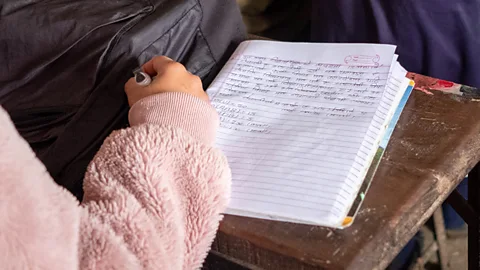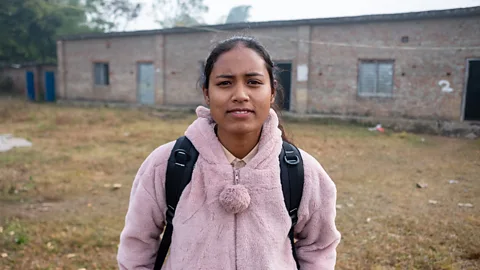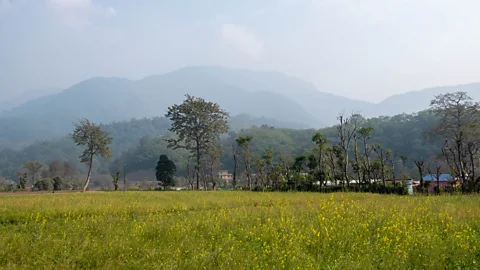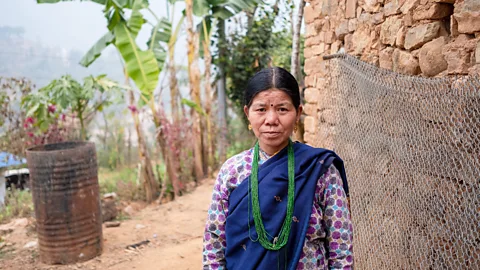The language that doesn't use 'no'
 Eileen McDougall
Eileen McDougallNepal's Kusunda language has no known origin and a number of quirks, like no words for "yes" or "no". It also has only one fluent speaker left, something linguists are racing to change.
Through the winter mist of the hills of the Terai, in lowland Nepal, 18-year-old Hima Kusunda emerges from the school's boarding house, snug in a pink hooded sweatshirt.
Hima is one of the last remaining Kusunda, a tiny indigenous group now scattered across central western Nepal. Their language, also called Kusunda, is unique: it is believed by linguists to be unrelated to any other language in the world. Scholars still aren't sure how it originated. And it has a variety of unusual elements, including lacking any standard way of negating a sentence, words for "yes" or "no", or any words for direction.
Best of 2022
This article is part of BBC Future's "Best of 2022" collection, where we bring you some of our favourite stories from the past 12 months. Discover more of our picks here.
According to the latest Nepali census data from 2011, there are 273 Kusunda remaining. But only one woman, 48-year-old Kamala Khatri, is known to be fluent.
The Kusunda are highly marginalised and impoverished within Nepali society. Today, most live in west Nepal's Dang district, a sleepy region of yellow mustard fields and misty, wooded hills. It is here the Language Commission of Nepal has been running Kusunda classes since 2019 in an effort to preserve the language. In the last decade, as the government of Nepal has launched schemes to help Nepal's indigenous groups, it has also begun paying for Hima and other Kusunda children from remote areas to board at Mahindra High School in Dang – sometimes as much as a 10-hour drive away – where they are also being taught their native language.
Hima, originally from the rural Pyuthan district bordering Dang, has been learning Kusunda for two years. She now is able to speak it at a basic level. "Before coming to school in Dang, I didn't know any Kusunda language," she says. "But I am proud to know Kusunda now, even though I didn't learn it from birth.
 Eileen McDougall
Eileen McDougall"I used to listen to other [ethnic groups], like Tharus and Magars, speaking their language, and wonder what it would be like to converse in my mother tongue. I think it is very important for me, and others, to protect this language."
A language on the brink
Originally semi-nomadic, the Kusunda lived in the jungles of west Nepal until the middle of the 20th Century, hunting birds and monitor lizards, and trading yams and meat for rice and flour in nearby towns. While they are now settled in villages, they still call themselves the Ban Rajas, or kings of the forest.
But as Nepal's population grew and farming increasingly fragmented the jungles, pressure on the Kusundas' homeland increased. Then, in the 1950s, the government nationalised great swathes of forests, presenting further obstacles to their nomadic life.
The Kusunda were forced to settle, turning to jobs in labouring and agriculture. Low numbers in the group and the disparate nature of their population meant they mostly married neighbouring ethnic groups. Almost all stopped speaking their language.
For the Kusunda people, losing their language means losing a link to their past, and to their identity.
From a linguistic point of view, it is a loss in other ways, too.
Madhav Pokharel, emeritus professor of linguistics at Tribhuvan University in Kathmandu, has been overseeing the documentation of the Kusunda language over the last 15 years. He explains that several studies have attempted to link it with other language isolates, such as Burushaski from north Pakistan and Nihali from India. But all have failed to find any robust conclusions.
 Eileen McDougall
Eileen McDougallCurrently, linguistic researchers believe Kusunda is a survivor of an ancient aboriginal language spoken across the sub-Himalayan regions before the arrival of the Tibetan-Burman and Indo-Aryan tribes.
"We can trace all other language groups in Nepal to people coming from outside Nepal," says Pokharel. "It is only Kusunda whose origins we don't know."
Alongside its mysterious beginnings, linguists have noted Kusunda's many rare elements. Bhojraj Gautam, a linguist with in-depth knowledge of Kusunda, describes one of the most peculiar: there is no standard way of negating a sentence. Indeed, the language has few words implying anything negative. Instead, context is used to convey the exact meaning. If you want to say "I don't want tea", for example, you might use the verb to drink, but in an adjusted form which indicates a very low probability – synonymous with the speaker's desire – of the drinking of tea.
Kusunda also has no words for absolute directions, such as left or right, with the speaker using relative phrases such as "to this side" and "to that side" instead.
Meanwhile, linguists say Kusunda does not have the set, rigid grammatical rules or structures found in most languages. It is more flexible, and phrases must be interpreted relative to the speaker. For example, actions are not divided into past and present. When saying "I saw a bird" compared to "I will see a bird", a Kusunda speaker might indicate the past action not by tense, but by describing it as an experience directly related to the speaker. Meanwhile, the future action would remain general and not associated to any subject.
Ironically, these rare qualities – a large part of what makes Kusunda so fascinating to linguists – are partly why it has struggled to continue.
Kamala Khatri, Kusunda's last fluent speaker, clasps a glass of hot water in Ghorahi's only coffee shop. She did not teach the Kusunda language to her own children, she says. "I thought they should learn Nepali because it is useful," she explains. "People would make fun of our language, and say it wasn't normal. Kusunda speakers faced a lot of stigma. But now I feel regretful that I can't converse with my own children in our own language."
 Eileen McDougall
Eileen McDougallKhatri is now working with the Language Commission, teaching Kusunda in Ghorahi to 10 community members. "If we can regularly practise, speak, sing our songs, then we might be able to keep our language alive," she says.
In Pokharel's view, collaborative learning among the remaining Kusunda is the key to the preservation of the language. He also emphasises the importance of the Kusunda speakers being in the environments in which they grew up to help stimulate their memories. "If we can bring all the Kusunda to the same place, in the habitat which they claim, then one Kusunda would tell his stories to another Kusunda, and this would revive their memories," Pokharel says.
Modern technology is also being employed in the current revitalisation efforts. NowHere Media, a Berlin-based media studio, has been working with the Kusunda to assist them in documenting their language, culture and traditions. Most notably, NowHere has produced a virtual reality documentary which uses 3D animation to depict the Kusundas' nomadic life as hunter-gatherers. NowHere co-founder Gayatri Parameswaran explains that the viewers, wearing headsets, are absorbed into this environment, and must learn and speak words in Kusunda to interact with the story and continue with the narrative. The overall aim, Parameswaran explains, is to create a digital archive that would be available to future generations.
Preservation of the Kusunda language, however, is only part of the story. According to Dhan Bahadur Kusunda, the chairman of the Nepal Kusunda Development Society, most Kusunda live below the poverty line, with no land rights, and work as labourers or porters. "Economically, socially, and in terms of health and education, the Kusunda are very disadvantaged," Kusunda says.
This is where raising awareness of the Kusunda language itself could help: it is an effective way of drawing attention to the Kusunda's marginalisation, says Lok Bahadur Lopchan, the secretary of the Language Commission. "Other language revitalisation projects in Nepal have been with communities that are much better off than the Kusunda," Lopchan says. "For these groups, language preservation it is just a sentimental idea. It doesn't bring them any other tangible benefits."
"The Kusunda however, are very marginalised and therefore it is more important to build a profile as a language speaking community."
Others agree. "If the Kusunda don't have their language, there is nothing to distinguish them from all the other marginalised groups in Nepal. The language is giving them an identity, and drawing the attention of the government," says Lopchan.
 Eileen McDougall
Eileen McDougallWith the help of researchers including post-doctoral fellow at University of London Tim Bodt, the Kusunda are now asking for a piece of land for an "ekikrit basti", or unified settlement, where all the Kusunda would live. Bodt and his Nepali research partner, Uday Raj Aaley, are currently looking for funding for a feasibility study for this new settlement.
According to Bodt, this settlement would not only secure the community's land rights and provide a health centre and school – it would also bring the group together, giving them the opportunity to learn and converse in their language.
Revitalised language, revitalised wellbeing
There are other potential benefits of revitalising the Kusunda language, too.
There is a growing body of research that has found indigenous language revitalisation associated with higher indicators of physical and mental wellbeing. Studies have found indigenous language use in North America to correlate with lower rates of cigarette use in the population, higher levels of physical and mental wellness indicators and lower levels of diabetes, for example.
Meanwhile, a study in British Columbia, Canada found that youth suicide was six times higher in indigenous communities where less than 50% of the members were conversationally fluent in their native language. In aboriginal and Torres Strait communities of Australia, indigenous language speakers exhibit lower rates of binge drinking and illegal drug use.
"Language shift is often associated with historical trauma from colonisation or oppression, and with loss of self-worth," says Julia Sallabank, professor of language policy and revitalisation at University of London. "So we can try to turn this round: reclaiming one's language and cultural identity can be empowering, at both personal and community level."
Back in Dang, one Kusunda member feels that way is 18-year-old Hima.
"I think I can take this language forward," she says. "If we can regularly speak and practice Kusunda, then we can keep the language alive. It's about having interest in our language and pride in our identity."
In the future, she says, she knows what she wants to do as a career: become a language teacher and teach Kusunda.
--
